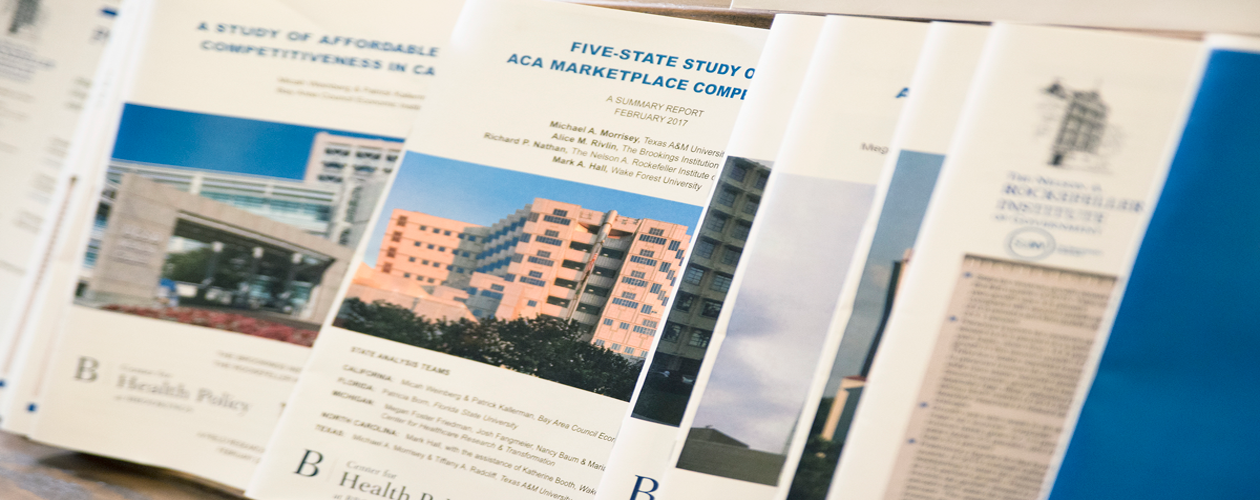Considerable Financial Contributions by the State and New Reforms Could Put the System on the Path Toward Financial Stability —If InvestmentReturn Assumptions Are Met
Today, the Rockefeller Institute of Government released a report that examines the potential implications of investment return volatility for the Pennsylvania Public School Employees’ Retirement System (PSERS) using the Institute’s state-of-the-art Pension Simulation Model. It also examines the implications of a recent reform that created a hybrid pension plan for new employees. PSERS was selected for study as part of the Rockefeller Institute of Government’s ongoing analysis of risks related to public pension systems
Albany, NY —Today, the Rockefeller Institute of Government released a report that examines the potential implications of investment return volatility for the Pennsylvania Public School Employees’ Retirement System (PSERS) using the Institute’s state-of-the-art Pension Simulation Model. It also examines the implications of a recent reform that created a hybrid pension plan for new employees. PSERS was selected for study as part of the Rockefeller Institute of Government’s ongoing analysis of risks related to public pension systems. PSERS is a defined benefit retirement plan for public school employees of the Commonwealth of Pennsylvania. The state and individual school districts are participating employers. As of June 30, 2016, PSERS had over 257,000 active members and approximately 225,000 retirees and other beneficiaries who receive over $476 million in pension and health care benefits each month. PSERS has an uncommon approach to funding under which some employees share partially in the plan’s investment risk, in certain circumstances. PSERS is deeply underfunded and faces greater challenges than other pension funds we have examined recently. At the end of the 2016 fiscal year, it had a market-value funded ratio of 50 percent and an unfunded liability of approximately $50 billion. PSERS currently uses a 7.25 percent earnings assumption. Recently it has fallen short of this assumption: its one-year, three-year, five-year, and ten-year annualized rates of return were 1.29 percent, 6.24 percent, 6.01 percent, and 4.94 percent, respectively, for periods ending on June 30, 2016. In an effort to improve the overall fiscal health of the fund and reduce risks to employers, Pennsylvania lawmakers recently changed the retirement benefit structure available to new state employees. New members of PSERS hired on or after July 1, 2019, will be offered three options for retirement benefits: two hybrid benefit options that include a defined contribution component in addition to a defined benefit component, and a pure defined contribution option. The defined benefit options will provide lower benefits than the current defined benefit plan for existing workers. The reform is intended to shift part of the funding risk, which is almost entirely borne by the state and school districts under the current defined benefit structure, to new employees. Overall the report finds that:
- Pennsylvania’s recent actions to pay full actuarially determined contributions, coupled with its conservative funding policy, mean that PSERS is on a path to full funding within a little more than two decades, if the state continues to pay full contributions and if investment performance is as good as the plan assumes.
- Contributions by the state and school districts will be significant over those two decades as they pay down current unfunded liabilities, and could rise or fall substantially depending upon investment performance.
- If assumed investment returns are achieved each and every year, PSERS will move toward full funding, assuming employers pay full actuarial contributions. However, investment returns almost certainly will vary from year to year, creating risks for the plan even if its underlying assumptions about investment markets are correct.
- We estimate that if underlying investment assumptions are correct, there is a 26 percent chance that the funded ratio of PSERS will fall below 40 percent —- what we consider to be crisis territory —- sometime between now and year 30. If investment return assumptions are too optimistic, the risks will be even greater.
- Because PSERS uses a relatively long 10-year asset-smoothing period, employers face little risk of sharp increases in contributions in short time periods, if investment returns fall short. Instead, short-term investment-return shortfalls could lead to deterioration in planned funding.
One conclusion that extends beyond PSERS is that a hybrid plan that includes a defined contribution component in addition to a defined benefit component can reduce the employer contribution risk substantially for employees in the hybrid plan. For example, a hybrid plan that provides a defined benefit component one-half as large as the current pure defined benefit plan and supplements it with a defined contribution component can lower employer contribution risk by roughly one-half. Although the percentage reduction in employer risk is large for affected employees, because hybrid plans usually apply primarily to new hires, as is the case with PSERS, it will be many years before it has a substantial impact on aggregate plan and employer finances. The reduction in employer cost uncertainty from a hybrid plan is accompanied by benefit uncertainty for employees. Substantially higher employer contributions would be needed to ensure that a hybrid plan is likely to provide benefits, under most investment scenarios, that are least as large as those guaranteed by the defined benefit plan. The latest report was authored by Yimeng Yin, programmer and research analyst, and Don Boyd, director of Fiscal Policy Studies. Kathleen Tempel, project manager and researcher, made significant contributions to the study. The project is supported by the Laura and John Arnold Foundation and The Pew Charitable Trusts. For more information on our findings on other pension funds, see www.rockinst.org/government_finance/pension.aspx.

